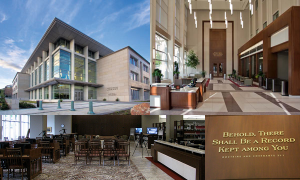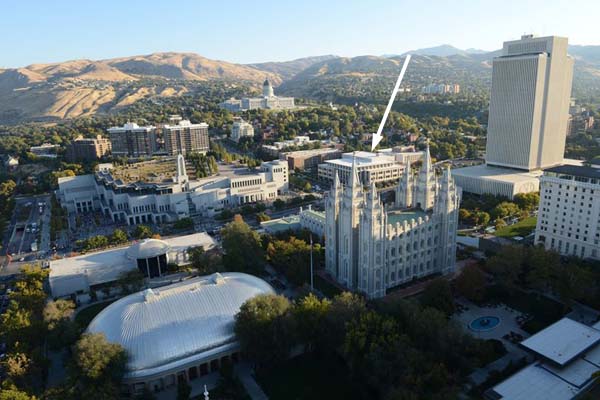The El Paso Inc. newspaper awarded its 2014 Community Spirit Award to UTEP’s Centennial Celebration. The celebration was intentionally designed to involve as many people as possible and the announcement cites 175 official events–and many more unofficial–that drew hundreds of thousands of participants, tens of thousands for some of the larger single events. On one day in October UTEP representatives visited every school in the city–more than 180,000 students–with a message to prepare for college. “You only get to celebrate a centennial once,” the announcement noted, “so you want to get it right, and by all accounts the organizers did.”
Read the full announcement at http://www.elpasoinc.com/news/local_news/article_a0f422b4-8f78-11e4-822d-232c17e5a2cd.html. See photos of the award ceremony at http://www.elpasoinc.com/news/el_pasoan_of_year/article_c35f2d56-b072-11e4-858e-d7124529b0e1.html.
[Note: Since 2012 I have been working with the American Historical Association to improve history teaching and learning at the undergraduate and graduate levels. As part of that initiative, I was invited to speak at the AHA’s annual meeting in New York City on January 5, 2015. This as a summary of my remarks and comments on that occasion.]
Today we have gathered to ask the question “What’s the Problem with Teaching?” For fourteen years, I taught history at three universities in every rank–from visiting to tenure-track to tenured–and at every level from undergraduate to doctoral. Last June I became the director of the LDS Church History Library and transitioned from encouraging students to go to an archive to overseeing those who help them when they arrive.
The archive is central to what historians do and to how we talk about what we do, from the 19th-century origins of our profession in the work of Ranke and his students to this very conference that seeks to re-connect history with related disciplines. So, where is the archive in our teaching? In an article published in the Journal of American History in 2011, I argued that teaching about historical thinking needs to occur in the places where historians think–one of which is the archive. I argued that such teaching was possible, shared successful examples of past archivally-placed teaching, and sketched out what such teaching might look like in the 21st century.
But now I sit on the other side of the reference desk. Instead of sending students merrily off to the archive, my team waits for them to arrive. Would you like to know how your students fare? Most show up having read some literature and with a topic or question in mind that shows some signs of having been narrowed. Good work. But very few of ours students know how to move from topic to answers. Here are some of the questions we might help them consider: What kinds of sources might answer my question? Where might those sources be today? Who might know about those sources and collections? How is a library catalog more powerful than Google? What is not in the catalog or online? Once we get them asking these questions we must prepare them for answers both expected and surprising–sometimes there are many sources, sometimes none; sometimes the sources are in one repository, most often they are in many, sometimes they are in very unlikely places; library catalogs do (!) know more than Google, but less than finding aids and the humans who produced both.
Therefore, I invite you to consider not just what students should do when they encounter a primary source in your classroom, but how to imagine that a source might exist somewhere and then how to go and find it in archive. If the archive is central to our work as historians, but has no place in our teaching, then are we really teaching our students to do history?
The AHA Program Committee has scheduled this session for:
Monday, January 5, 2015: 11:00 AM-1:00 PM | New York Hilton, Sutton North
272. What’s the Problem? Turning Teaching Questions into Scholarship of Teaching and Learning Research
Co-Sponsor(s): AHA Teaching Division
Chair: Laura M. Westhoff, University of Missouri–St. Louis
Lendol G. Calder, Augustana College
Keith A. Erekson, University of Texas at El Paso/LDS Church History Library
David P. Jaffee, Bard Graduate Center
Leah Shopkow, Indiana University Bloomington
@KeithAErekson asks if we are really teaching students to do history if we aren’t including archives in our teaching #aha2015
— Clio (@thecliodotcom) January 5, 2015
[Note: After Elder David A. Bednar invited Latter-day Saints to use social media more effectively, our local Sunday School began a weekly how-to class. I have been assigned to teach the course’s final lesson on December 28, 2014, and have placed the materials for the lesson on this Pinterest board. The pins are numbered on the board and identified below in parens ( ) .]
Get Started
- On (1) lds.org, in the blue footer at the bottom, click on (2) “All Church Social Pages” – a new page will open with information about each of the channels and a list of Church hashtags
- It is interesting to see how marketers compare the channels
2. Create an Account on the Channel(s) of your Choice
- On a computer, type the channel’s URL in browser (Facebook.com, Twitter.com and so on)
- Or, on a mobile device, find the app by typing the URL in a browser or through your device’s “store” (App Store on Apple, Play Store on Android)
- Follow the instructions to create an account, which will typically involve providing an email address (or another social media account) before creating a username and password
Be . . . Yourself | Positive | Law-Abiding | Aware | Flexible | Curious | Fearless
Follow and Share
3. Follow Church Accounts with Your Account(s)
- On (1) lds.org, in the blue footer, click the social media icons to find the Church’s official accounts
- On (1) lds.org, in the blue footer, click on (2) “All Church Social Pages” and then on the channel of your choice to find more accounts to follow
4. Share Church-Produced Content through Your Account(s)
- To share anything from (1) lds.org, click on it. When the item opens then click one of the social media icons that appear on the page or in the video viewer frame or on an images when you hover over it. (For Facebook, you can always just copy/paste the URL of a page and share in your status update or message.)
- Use a hashtag in (find a list at the bottom of (2) “All Church Social Pages”)
- There is also a page with (3) “Inspirational Picture Quotes“
- Visit (4) social.lds.org for ideas and examples of how to share
Go Mobile
5. Use Church Apps on your Mobile Device(s)
- On (1) lds.org, in the top right corner, click on “Sign in/Tools” to create an lds account (requires membership record number; you will create your own username and password)
- On (1) lds.org, in the blue footer, click an app icon or on (5) “All Church Mobile Apps” to be taken to an information page
- Or, find the apps in your device’s store (App Store on Apple, Play Store on Android)
- After the app is installed on your device, the first time you click on it you will be asked for your lds account information
6. Share Content Directly from the Church Apps
- LDS Tools – send an email or text to a list
- LDS Gospel Library – share publications, videos, images
- Mormon Channel – share videos and messages
- FamilySearch Tree – view and share information from your tree
- FamilySearch Memories – create and link photos and video
Tip: The sharing icons may look different or appear in different places depending on the app. If you are on Android, look for “share” in the menu. Be curious.
Create
7. Create Content for Others to Share
- Visit (6) create.lds.org to submit your own photos, music, or videos for others to share
Links
(2) https://www.lds.org/media-library/social
(3) https://www.lds.org/media-library/images/categories/inspirational-picture-quotes
(5) https://www.lds.org/pages/mobileapps
(This page) https://www.keitherekson.com/2014/12/share-goodness/
Follow Keith’s board #ShareGoodness on Pinterest.
Click on the image below or visit pinterest.com/KeithErekson/sharegoodness/ to see the Pinterest board.

 I have accepted the invitation to serve as the director of the Church History Library of The Church of Jesus Christ of Latter-day Saints. In this role, I look forward to sharing the Church’s history with its more than 15 million members, more than 5 million annual visitors to Temple Square, and many other interested researchers and other institutions. I take with me a profound sense of gratitude for the ways that UTEP’s traditions of opportunity and believing in dreams have transformed my life through the privilege of teaching UTEP students, serving El Paso teachers, and commemorating the history and accomplishments shared by the University and city.
I have accepted the invitation to serve as the director of the Church History Library of The Church of Jesus Christ of Latter-day Saints. In this role, I look forward to sharing the Church’s history with its more than 15 million members, more than 5 million annual visitors to Temple Square, and many other interested researchers and other institutions. I take with me a profound sense of gratitude for the ways that UTEP’s traditions of opportunity and believing in dreams have transformed my life through the privilege of teaching UTEP students, serving El Paso teachers, and commemorating the history and accomplishments shared by the University and city.
About the Church History Library
The Church History Library is dedicated to preserving and sharing the history of The Church of Jesus Christ of Latter-day Saints, the fourth largest Christian church in America. The library opened in June 2009 and has since welcomed thousands of people interested in learning more about the history of the faith and its members. The 230,000-square-foot facility contains five floors that include a public library and reading room and storage space for thousands of books, pamphlets, unpublished records, patriarchal blessings for Church members, photographs, and audio and video recordings.

The Church History Library is located at Temple Square in Salt Lake City, Utah–east of the Conference Center, north of the Church Office Building, and down the hill from the Utah State Capitol.
Links
LDS Church History Library
https://history.lds.org/section/library [website]
http://churchhistorylibrary.lds.org [catalog]
http://www.mormonnewsroom.org/article/church-history-library [about]
The Church of Jesus Christ of Latter-day Saints
https://www.lds.org
Frequently Asked Questions about Mormonism
http://www.mormonnewsroom.org/article/mormonism-101
UTEP Media Releases
Center Announces Interim Director (April 25, 2014)
Centennial Museum Director to Lead UTEP’s Centennial Celebration (April 1, 2014)
For approximately half a century, it was accepted that classes began at the Texas School of Mines (now UTEP) on September 23, 1914. The histories written for the school’s 50th and 75th anniversaries mentioned the 23rd, but a closer reading reveals that the authors harbored some questions–questions that would not be answered until the 100th anniversary.
First Histories
In his narrative of the events of 1914 for the 50th anniversary, English professor Francis Fugate noted that after Worrell arrived in El Paso “It was soon announced that the school would open on September 23” (pp. 11-12). Fugate did not cite a source, but must have discovered one of the announcements in the El Paso Herald (May 4, p. 3) or El Paso Morning Times (May 5, p. 3; Aug. 30, p. 24) that did in fact mention September 23. Yet, when it came time to describe the opening, Fugate said only “The doors of the school opened on September 23, as scheduled” (p. 14), hinting that he was unable to confirm the school’s opening date and simply followed the announcements.
A quarter of a century later, Nancy Hamilton tried to retrace Fugate’s steps. Her research took her to the city’s newspapers where she came up short of a confirmation, reporting “The opening of the School of Mines was not even mentioned in the September 28 El Paso Herald account of a meeting of the Board of Regents.” She therefore relied on Fugate to write that “Twenty-seven students entered the School of Mines on opening day, September 23” (p. 19). Clearly, Hamilton was looking for corroboration but the only answer was silence.
A New Question
In August 2013, while preparing for the new tradition of New Miner Convocation, I asked P. J. Vierra, a doctoral students working in UTEP’s Centennial Office, to verify the number of students enrolled at TSM on the first day of class. He came back with some published numbers that contradicted each other–21 here, 24 there, 29 in another spot–but it was the source for one of the numbers that startled us most:
“The El Paso School of Mines opened Monday for its initial session.”
—El Paso Herald, Sept. 30, 1914, p. 6
The El Paso Herald was published in the evenings, Monday through Saturday. This story, published on Wednesday, September 30, stated that classes began on September 28!
The Hunt for Confirmation
The first task at hand was to verify the newspaper’s report. The Herald had already published September 23 as the start date and this particular article even contradicted itself, stating in one paragraph that 24 students were enrolled and then later listing only 21. We were not ready to rely on the word of the Herald alone.
At first, all we could find was context. The El Paso Morning Times (published the morning after the Herald) confirmed that Worrell had spoken to the press the day before, stated the date for the first football practice, cited 29 students–but no first day of classes. On September 28, the Herald ran a report of the first day of class at the University of Texas (in Austin) but did not link to TSM. Bulletins published in subsequent years confirmed that TSM opened in “September” (no date) 1914 and that it eventually adopted the UT start date of September 28 as an annual tradition, but they did not confirm that it actually happened that way in 1914.
More disconcerting were the silences. There was simply nothing at all about the school in the El Paso Morning Times from September 1-30. The minutes of the meetings of the Board of Regents (three of them that year) discuss deeds, appropriations, and expenditures but no start date. Various state and local newspapers noted the school’s opening, but none mentioned a date for the first day of class. Did UTEP’s Special Collections department have a collection of newspaper clippings? No. Any special set of papers related to the school’s founding? No again.
There was only one remaining hope, but it was a hopeless one. The minutes of the October 27 meeting of the Board of Regents cited a letter from Worrell dated September 22. Its purpose was to identify faculty whose salaries should be paid. The minutes did not reproduce the letter; they only mentioned it. Did the letter still exist somewhere? If it did, could it be found? If it were found, could answer the question? Since Worrell was writing on the eve of the first day of class, would he not have mentioned something about the events of the next day? But where was the letter? No collection of Worrell’s personal papers has survived, neither at UTEP nor in Austin. Some of his correspondence has been recovered in the collections of other persons, but to track it down that way would take another century.
Then we remembered an anomaly. A few weeks earlier, while looking at the inventory list for the collection of UT Presidents Papers at the Dolph Briscoe Center in Austin, P. J. had discovered two boxes of papers related to the Texas School of Mines. Could these boxes contain the September 22 letter that Worrell sent to the Regents? Possibly. Were the papers accessible? Sort of. The papers are stored off site and require 3-5 days to retrieve. Would the archivist call up the boxes and look for a specific letter? Yes. All we could do was wait.
“registration begins with us tomorrow”
–Dean Steve H. Worrell, September 22, 1914
Confirmed, in black and white, by none other than the dean himself. Registration on September 23, first day of classes on September 28, 1914. A century later, UTEP is an aspiring tier-1 public research university. Every day, somewhere on campus, a discovery is made by one of UTEP’s faculty and student researchers–from cancer treatment to space travel to water desalination to frog species. This time, the discovery happened to be about our own history. It is a humbling and exciting time to be a Miner.
References
Bulletin of the University of Texas, No. 312 (Jan. 20, 1914): Catalogue 1913-1914, p. 4; No. 5 (Jan. 20, 1915), p. 451; No. 1723 (Apr. 20, 1917): Catalogue 1916-1917, p. 522; No. 1925 (May 1, 1919): Catalogue 1918-1919, p. 304.
El Paso Herald, May 4, 1914; September 15, 16, 21, 28, 1914.
El Paso Morning Times, May 5, 1914; August 30, 1914; October 1, 1914.
Fugate, Frontier College, (1964), 11-14.
Hamilton, UTEP: A Pictorial History (1988), 19.
“Minutes of the Meetings of the Board of Regents,” April 28, 1914, pp. 347-348; June 8, 1914, pp. 397, 401; October 27, 1914, p. 414.
Worrell, Steve to President of University of Texas, September 22, 1914, UT President Papers, Box VF 8/A.a “College of Mines and Metallurgy (El Paso), 1913-1927.”
Tags
Access Policy Analogies Angel Moroni Archives & libraries Awards Black history Careers in History Church History Library Church History Speaking Come Follow Me Commemoration Conspiracy Theories Contingent Citizens Databases Elvis Presley Forgery Everybody's History Family History & Genealogy First Vision Foundations of Faith Genealogy Speaking History Skills History teaching & learning Hoaxes and History 2019 How History Works In the Church News Kirtland Temple Lincoln Making Sense of Your Patriarchal Blessing Missionaries Mormon studies Mormon Women's History Mother's Day Patriarchal Blessings Pioneers Politics Primary sources Questions and Answers RealvsRumor Saints Saints (narrative history) Sensible History Stories Texas social studies UTEP Centennial WitnessesDisclaimer
The views expressed here are the opinions of Keith A. Erekson and do not necessarily reflect the views of the Church History Department or The Church of Jesus Christ of Latter-day Saints.


